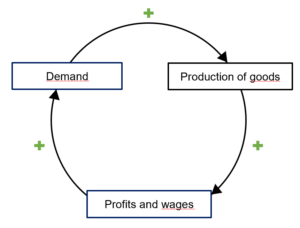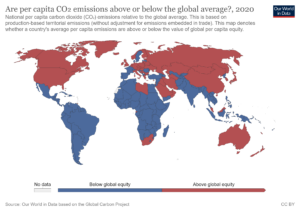Xavier Michel
In recent decades , millions of people have lifted themselves out of extreme poverty, and consumption has continued to rise. The development of sustainable products has opened up new opportunities for many companies to redevelop themselves. But these products must not only be produced but also consumed. Therefore, it is important to focus on the demand side and understand consumers to further promote the use of sustainable products and develop the industry towards sustainability.
When thinking about futuristic industries, one might think of technologies like flying cars, robots doing most of the daily tasks or elements from the movie “Back to the future”. But what will it actually look like when we develop industry in a sustainable way even better, if we develop them according to the SDGs? In the last three decades, extreme poverty has been constantly decreasing (Graph 1) and consumption has also risen.

Graph 1: World population living in extreme poverty from 1820 to 2015 (Ravallion 2016)
The problematic use of the virtuous cycle
By steadily increasing the demand, there is a rise in welfare as more demand is translated into the production of more goods, increasing profits and wages, that further increase demand and production. This system (Graph 2) is a positive feedback loop depicted as a virtuous process, but this is actually hurting the environment (United Nations Industrial Development Organization 2015). This loop can also be described as reinforcing, as it amplifies the effect of the whole process.

Graph 2: Virtuous cycle of current economy in most developed countries
Three main problems consist when it comes to continuing this specific virtuous cycle, present in most developed countries (United Nations Industrial Development Organization 2015).
- Growing and sustained demand for products requires the use of non-renewable natural resources, that would be consumed at a non-sustainable pace
- The production of manufactured goods often requires the burning of carbon, emitting greenhouse gas emissions, leading to climate change
- Products need to be disposed of. If policies for recycling or reuse are not adopted and enforced, waste disposals will cost a lot
Therefore, we need to develop a way to produce more sustainably. But what is a sustainable industry? Using the Brundtland Commission’s definition, a sustainable industry development would be a development that meets the needs of the present without compromising the ability of future generations to meet their own needs. The main SDGs involved when thriving towards this development are number 8 (decent work and economic growth), 9 (industry, innovation and infrastructure) and 12 (responsible consumption and production) (UN 2015). The indices established to verify the achievement of these goals show that SDGs 8 and 9 are making decent progress (Sachs et al. 2021). But the development of the industry is heavily focused on the supply side by fostering innovation or producing fewer polluting goods (GRI 2022). To develop it further, there is a need to include the demand side and focus on sustainable consumption. But is the demand for sustainable production and industrial development present?
Increase of welfare fostering consumption
As the United Nations Environment Programme (UNEP) reported in 2018, human demand for the Earth’s natural resources exceeds what can be produced, and consumption continues to rise. There is a definite need to decouple economic growth from the use of unsustainable natural resources. Inequalities in consumption exist not only between but also within countries (UNEP 2017). This can be seen (Graph 3) by comparing the average CO2 emissions of individual countries with the global average. The countries shown in red are above average and consume more than the countries shown in blue, showing a clear pattern of overconsumption in the more developed countries.

Graph 3: Distribution of per capita CO2 emissions above or below global average (Global Carbon Project 2017)
This high consumption pattern intensifies the impact on the environment, due to increased pollution, overuse of natural resources, and creation of waste (Sachs et al. 2021). Many developed countries have made progress on the SDGs, but most also still score poorly on goal number 12.
Impact of consumer behaviour
To achieve sustainable consumption, it is critical to understand human behaviour and what drives consumption decision making. The small, everyday actions of many people add up to an overall consumption pattern. The decision of what to consume is influenced by many factors such as availability, price and quality of sustainable options (UNEP 2017). These are factors that can be clearly identified, but there are also other factors such as the behaviour of people around the consumer or the cultural context that can play an important role and are not so easy to identify. The importance of sustainable consumption is already widely recognized, but even most people who have access to sustainable options do not change their behaviour. This is particularly evident when looking at surveys where many people are considering sustainability, but few are taking action towards sustainable consumption.
Behavioural science has proven that individuals generally care about the environment, but that those good intentions are not always translated into environmental-friendly behaviours. This may be related to the factors already mentioned, but also to behavioural barriers that prevent intentions from becoming actual actions. Here are five behaviours that have been identified as barriers (UNEP 2017):
- Many consumption “choices” are often habitual behaviours: people live by daily routines and often do not make intentional choices when consuming, but are guided by habits.
- The consequences of consumption are often difficult to recognize: it is difficult to see the long-term consequences of unsustainable resources. This is especially true for water and energy, also known as “invisible” resources because it is difficult to keep track of what a person consumes of these resources on a daily basis.
- Sustainable consumption does not necessarily seem to be personally relevant: individuals may understand how their consumption affects the system as a whole, but think their actions have no relevant impact.
- Behaviours are influenced by peers and social groups: especially in moments of uncertainty, individuals may have moments of doubt and be easily influenced by peers.
- Sustainable choices can be difficult to follow: sustainable options may be advertised, but so may unsustainable options, making it more difficult to comply with a limited range of sustainable products. Customers may also be automatically assigned the non-sustainable option, as in the energy sector, where they must choose to be supplied with renewable energy.
Solution approach
In short, the solution is to produce and consume environmental goods in a more sustainable way, generating less waste. As stated earlier, the supply side is making decent progress by providing goods at a higher cost but produced in a more sustainable manner. On the demand side, the focus should be on policies that promote understanding and application of consumer behaviour principles. By creating policies that aim to change these habits in a sustainable way, greater change in overall consumption patterns could be achieved. In terms of behavioural barriers, there is a need to interrupt daily habits that are unsustainable, and in this regard, physical cues can be particularly important, as they can be a constant reminder that there is an option other than a permanent habit. There should also be greater awareness-raising, pointing out the impact of individual actions on the environment and how each positive action can help solve a larger problem. Finally, sustainable products need to be as easy to use as non-sustainable ones, so that they do not require extra effort to be used.
References:
Global Carbon Project. 2021. Are per capita CO₂ emissions above or below the global average? https://ourworldindata.org/grapher/per-capita-co2-vs-average.
GRI. 2022. Inventory of Business Indicators – SDG Compass. https://sdgcompass.org/business-indicators/
Ravallion. 2016, World population living in extreme poverty. https://ourworldindata.org/grapher/world-population-in-extreme-poverty-absolute.
Sachs, Kroll, Lafortune, Fuller, and Woelm. 2021. Sustainable Development Report 2021. https://dashboards.sdgindex.org/.
- 2015. THE 17 GOALS | Sustainable Development. https://sdgs.un.org/goals.
UNEP. 2017. Consuming Differently, Consuming Sustainably: Behavioural Insights for Policymaking | Department of Economic and Social Affairs. https://sdgs.un.org/publications/consuming-differently-consuming-sustainably-behavioural-insights-policymaking-18050.
United Nations Industrial Development Organization. 2015. Industrial Development Report 2016. The Role of Technology and Innovation in Inclusive and Sustainable Industrial Development. Overview.